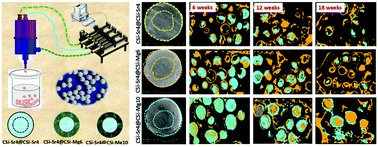Core–shell-structured nonstoichiometric bioceramic spheres for improving osteogenic capability
Abstract
A rational design of fully interconnected porous constructs of biomaterials with controlled pore-wall bioactivity and biodegradation is of importance in the advancement of bone regenerative medicine. We hypothesize that the layered structure of hybrid bioceramics produces time-dependent biological performances to tune osteogenic responses. We thereby developed core–shell-structured nonstoichiometric Ca silicate (nCSi) spheres and evaluated the effect of spatiotemporal distribution of bi-component nCSi on osteogenic capability. The alginate-based 4% Sr-, 6% Mg-, or 10% Mg-doped nCaSi (i.e. CSi-Sr4, CSi-Mg6, CSi-Mg10) slurries were extruded into a Ca2+-rich solution through the core or shell layer of a coaxial bilayer nozzle, and after drying and sintering treatments, the core–shell nCSi ceramic spheres were prepared. The improved sintering property and denser structure of CSi-Mg6 and CSi-Mg10 shells readily retarded bioactive ion release and biodegradation of CSi-Sr4@CSi-Mg6 and CSi-Sr4@CSi-Mg10 spheres compared with those of CSi-Sr4@CSi-Sr4. When the spheres were implanted into the femoral bone defect in rabbits, the differences in biodegradation and bone regeneration rate in relation to microsphere scaffolds were measured at 6–18 weeks post-implantation. CSi-Sr4@CSi-Mg10 showed slow biodegradation and new bone regeneration, whereas CaSi-Sr4@CSi-Sr4 showed a much faster degradation such that a low osteogenic capacity was observed with prolongation of time. However, CSi-Sr4@CSi-Mg6 spheres displayed expected biodegradation and osteogenic activity with time. These results confirmed the slight tailoring in both doping ions and that component distribution of nCSi is beneficial for adjusting osteogenesis of core–shell spheres. By rationally choosing foreign ion doping, this concept may represent a versatile strategy for the production of a variety of core–shell bioactive ceramics for bone regeneration and repair applications.



 Please wait while we load your content...
Please wait while we load your content...